Art History
Was Botticelli’s Famed ‘Birth of Venus’ a Fertility Symbol?
The painting doesn't actually show the goddess's birth, for starters—and other facts you might not know about this Renaissance masterpiece.
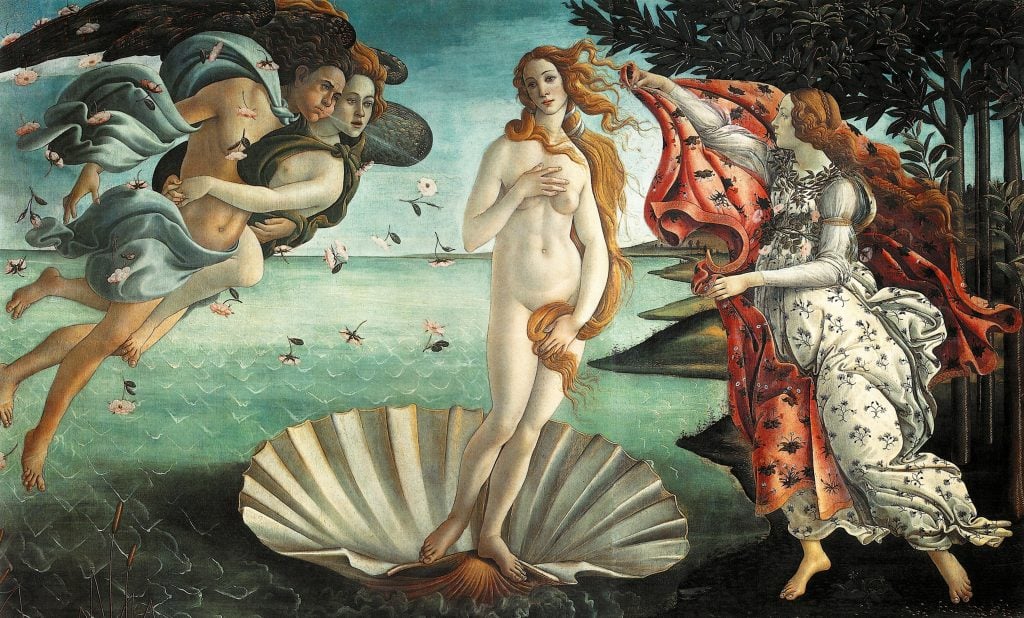
The goddess perches upon a giant scallop shell, pale green waves lapping around her. Her long golden hair rustles in the wind as she is blown to shore upon her seashell vessel. She is nude, her body as smooth as a carved marble, and she gestures delicately, hands hovering as though feigning to conceal herself. Roses, flicked with marks of gold, float in the air around her.
The painting, the Birth of Venus by Sandro Botticelli, is one of the most celebrated and reproduced images in the history of Western art—and one that remains curiously enigmatic. A star of the Uffizi’s collection in Florence, this beloved vision of the goddess of love (Venus to the Romans, Aphrodite to the Greeks) was an unprecedented work when it was painted around 1485.

Sandro Botticelli, Birth of Venus (c.a. 1485). Collection of the Uffizi Galleries. Photo by Universal History Archive/Getty Images)
Painted with a thin tempera, the Birth of Venus was among the earliest Tuscan Renaissance paintings on canvas—a lightweight, affordable, and innovative base compared to the traditional wood panel. Even more daring, The Birth of Venus marked the first European representation of female nudity outside of a religious context since antiquity.
Even a cursory glance at the canvas confirms that this is no shame-ridden Eve exiled from Eden, or Mary Magdalene awakened to the perils of her vanity. Instead, Venus gazes out serenely, nary an emotion or thought discernible on her lovely visage, with a beauty and vessel-like potentiality, that has continued to captivate viewers over the centuries— inspiring artists including Andy Warhol, Yin Xin, and Awol Erizku in their own interpretations.
The Basics
What exactly are we meant to see when we look at the Birth of Venus?
For starters, the title is a bit misleading—this is not the goddess’s birth, emerging fully formed from seafoam, and wringing her hair (a type of image known as Venus Anadyomene). The confused title of Botticelli’s masterpiece was bestowed by Giorgio Vasari decades after its creation. Instead, Botticelli presents the next part of her story; her arrival on the island of Cyprus or Cythera. To the left of Venus, we see Zephyrus, the West wind, and his wife Chloris (or Aura, a personification of a breeze) who blow the goddess to shore. Meanwhile, on the right of the canvas, a young maiden, believed to be a personification of a Horae, Greek minor goddesses of the seasons and times, opens her arms, enveloping Venus in a billowing shawl as she arrives on the island.
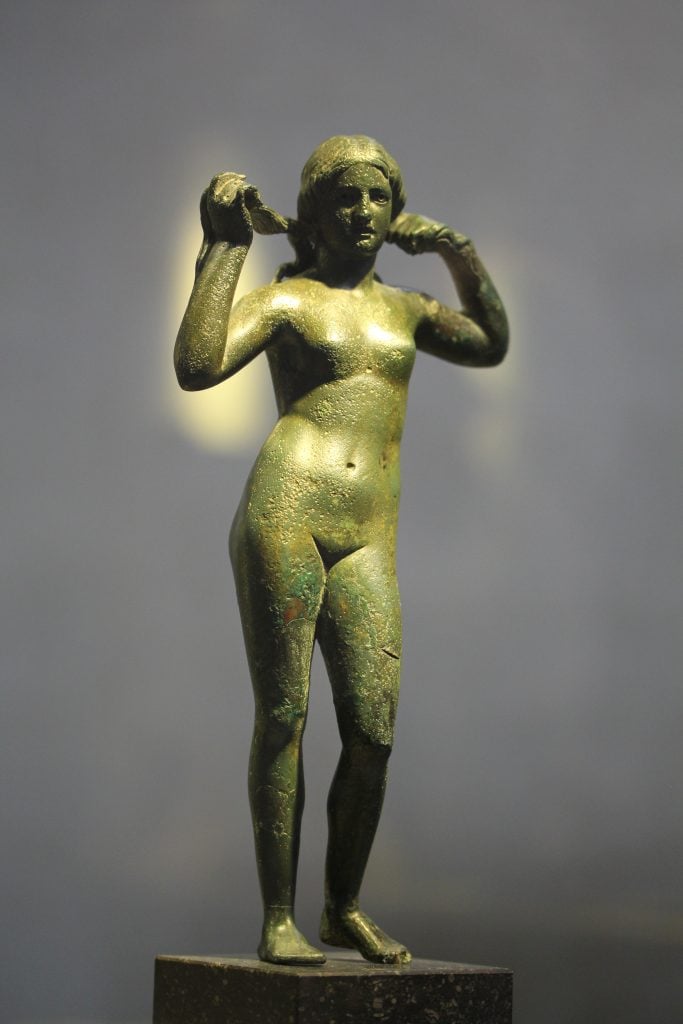
Venus Anadyomene, 1st or 2nd century. Collection of the Musée Royal de Mariemont.
The maiden’s robes are adorned with cornflowers and primroses, which bloom in spring and summer. In the background, a landscape is depicted in a flattened stage-like arrangement atypical of the Renaissance focus on realism and proportion. While no one is certain whom Botticelli painted the work for, it has long been presumed that the Birth of Venus was commissioned for the powerful Medicis, perhaps for Lorenzo di Pierfrancesco de’ Medici, one of Botticelli’s major patrons, or perhaps for his cousin Lorenzo de Medici (the laurel wreath around the Horae’s neck and the laurel trees in the upper right are likely puns to the name Lorenzo).
Real gold, meanwhile, fills the canvas, accenting the scallop shell, the roses, Venus’s hair, and more, a technique that hints back to Botticelli’s training as a goldsmith. In its hodgepodge assortment of references and styles, the Birth of Venus seems to ask more questions than it answers. As the deepest days of summer set in, we took a closer look at this iconic, oceanic scene and found three interpretations that might help you see it in a new way.
Botticelli Fused Mythical and Divine Love
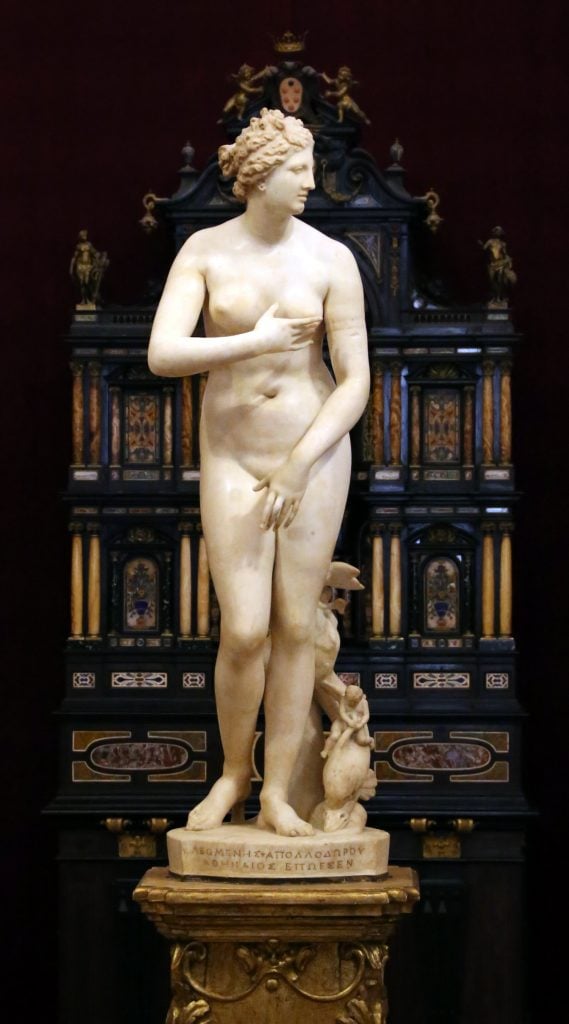
Medici Venus, by Cleomenes (Late 2nd century B.C.E. to Early 1st century B.C.E.). Collection of the Uffizi Gallery.
The numerous art historical allusions at play in this composition can be surprising, and at times feel contradictory. Firstly, Venus’s pose, with her right arm crossing her breast, and left arm reaching down to shield her groin, harkens to the Greco-Roman tradition of the “Venus Pudica”. Such sculptures show Venus coyly shielding her breasts and mons pubis with her hands as though taken by surprise. Botticelli might have been inspired Venus de’ Medici, a marble sculpture of the goddess dating to 1st-century B.C.E.
This reference to classical Greek depictions of the goddess is in keeping with Renaissance interests in humanism and proportion—but Venus’s comportment is not purely a reflection of these ideals. Her figure also embraces visual strategies found across centuries of Catholic religious art. Historians have, in particular, noted the similarities between the Birth of Venus and Lorenzo Ghiberti’s 14th-century bronze depiction of the baptism of Christ, which appears on the doors of the Florence baptistery. In Ghiberti’s bronze panel, Christ almost emerges into three dimensions—his feet in the river covered in swirling water. Like Venus, he is flanked on both sides. On the right, John the Baptist reaches out to pour water on Jesus in a gesture not unlike the welcoming arms of Botticelli’s maiden. To the left, a group of angels are entangled in an impossible embrace similar to that of Zephyrus and Chloris.
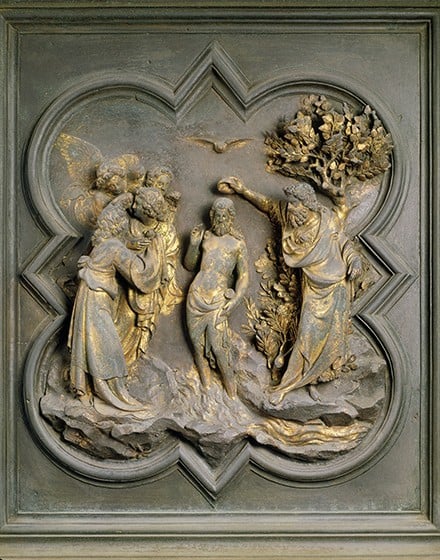
The Baptism of Christ by Lorenzo Ghiberti (1427).
Meanwhile, famed art historian Kenneth Clark linked Venus’s swaying contrapposto to Gothic sculptures of the Madonna and Child, an odd choice for the Renaissance that celebrated anatomical realism. “Her whole body follows the curve of a Gothic ivory,” Clark writes, “It is entirely without that quality so much prized in classical art, known as aplomb; that is to say, the weight of the body is not distributed evenly on either side of a central plumb line.”
Why this conflation of mythological and religious imagery, we might ask? That might come down to Neo-Platonism, an ancient philosophy that garnered renewed attention during the Renaissance. At its core, Neo-Platonism espouses that our reality mirrors a larger divine reality. The Medicis, the likely patrons behind the Birth of Venus, were followers of the philosophy, with Lorenzo “il Magnifico” even hosting a Platonic Academy during the 15th century. Thus, according to art historians including E.H. Gombrich, reflecting upon the physical beauty of Venus, the goddess of love, we become sensitive to the beauty of divine love.
A Fertility Image
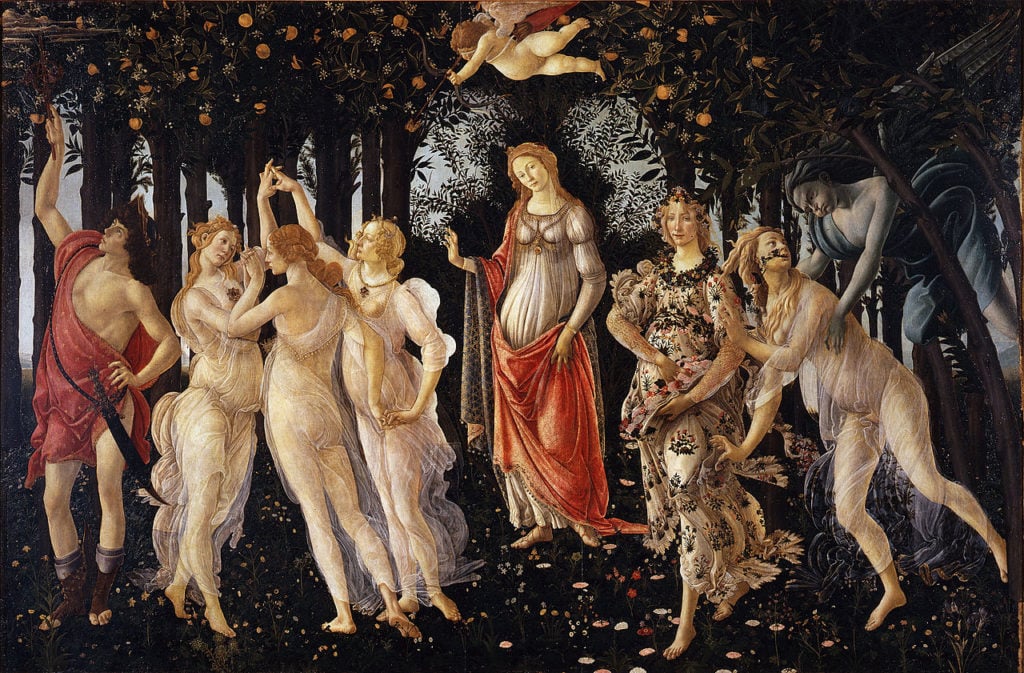
Sandro Botticelli, Primavera (circa 1482). Courtesy of the Uffizi Gallery, Florence.
At the Uffizi, the Birth of Venus hangs nearby to Botticelli’s earlier masterpiece Primavera, a symbolic painting of spring that shares stylistic similarities with Birth of Venus. In Primavera, Venus appears again as a blonde woman, with long flowing tresses, though here she is clothed. The figures of Zephyrus and Chloris also appear but here on her right, while the Three Graces and a man with a striking resemblance to Lorenzo de’ Medici appear on the left of the canvas. Many scholars believe both Primavera and the Birth of Venus were commissioned by the Medici family. At the very least, Giorgio Vasari saw both paintings at Castello de Medici in the years before the publication of Lives of the Artists in 1550 (so around the 1530s/40s).
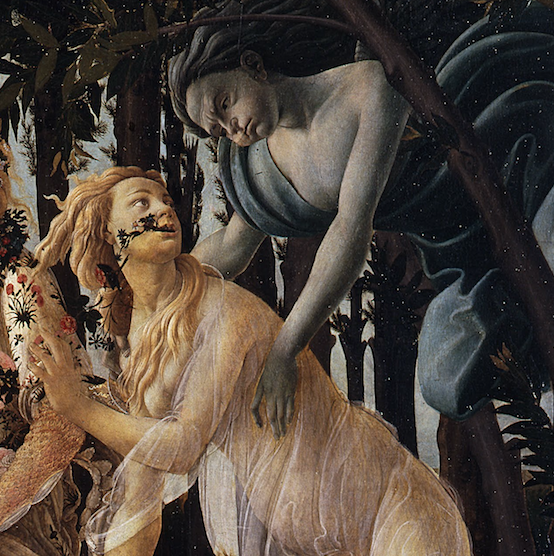
Detail of Primavera by Sandro Botticelli.
Both scenes would have been unprecedented at their time as large-scale mythological masterpieces. The two paintings share a tapestry-like flatness and were displayed in the same room at the Medici castle. Given their similarities, Primavera may offer clues to the meaning of the Birth of Venus. Primavera, scholars believe, was commissioned by Lorenzo de Medici as a wedding gift to his cousin, as a celebration of the marriage union, leading many to speculate that the Birth of Venus builds upon Primavera‘s nuptial significance, and is a fertility image that suggests hope for an heir.
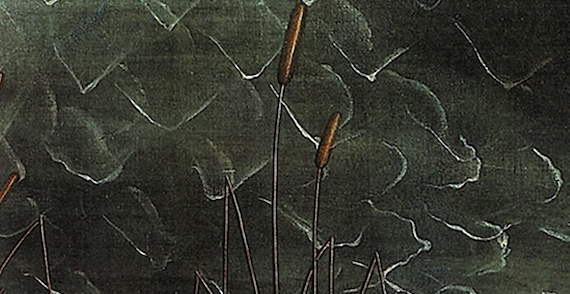
Detail of the Birth of Venus (1485) by Sandro Botticelli.
In this reading, Botticelli’s allusions to scenes of Christ’s baptism mentioned earlier might take on a new light. The scallop shell had evolved into a Christian symbol of baptism, but in the ancient world, the shell represented the vulva, making allusions to childbirth. Some even speculate that Botticelli snuck a bawdy joke into the composition. The bulrushes visible along the edges of the water are a freshwater species, and otherwise out of place in the oceanic scene. Their inclusion may instead hint at Venus’s actual birth story.
The goddess was born as a fully formed woman from the seaspray after Saturn castrated his father, the god Uranus, and threw his testicles into the ocean. The bulrushes, then, are a winking phallic symbol, hinting at the goddess’s comical birth story and procreation more broadly.
It Takes Poetic License, Literally

Detail of the Birth of Venus (1485) by Sandro Botticelli.
The longer one looks at the Birth of Venus the more it reveals itself as a playfully impossible image. Nothing is too literal; just as Venus’s body is elongated beyond realistic proportions, so too, we realize that her figure carries no weight—a real figure would tip the mammoth shell forward. The maiden too, floats just over the ground, while the tangle of Zephyrus and Chloris’s limbs is contorted beyond physical possibilities. Botticelli’s art historical allusions can seem equally whimsical—a mishmash of references.
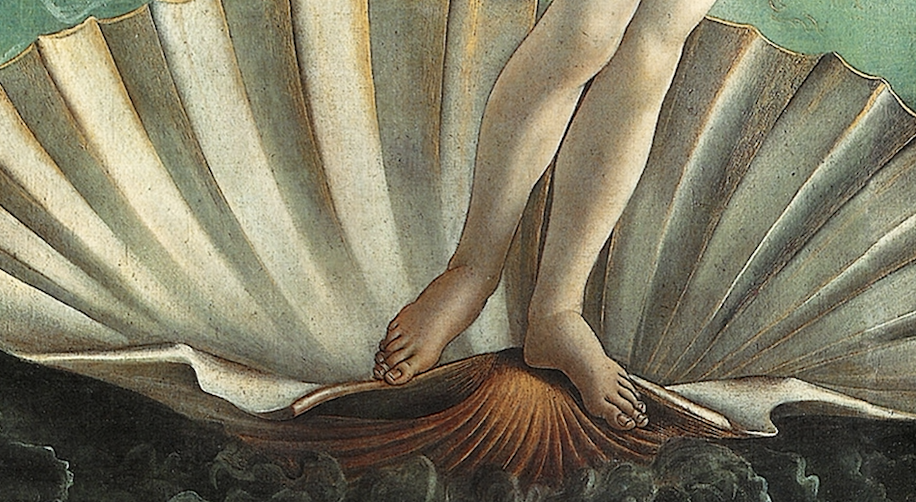
Detail of the Birth of Venus (1485) by Sandro Botticelli.
But perhaps this synthetic approach didn’t start with Botticelli; many believe that the imagery in the Birth of Venus was inspired by the poem “Stanze per la Giostra” (1475–8) by Angelo Poliziano, who also worked in the Medici court in Florence. Passages from the poem include the lines, “a young woman with nonhuman countenance/ is carried on a conch shell/ wafted to shore by playful zephyrs; and it seems that heaven rejoices in her birth.” While the poem and painting are certainly not a one-to-one translation, they do share striking similarities (read more here) and ekphrasis—a tradition in which an artwork inspired lyrical writings—were not uncommon in Late Antiquity. Poliziano’s poem, much like Botticelli’s painting, builds on associations, juxtapositions, and unexpected harmonies.





